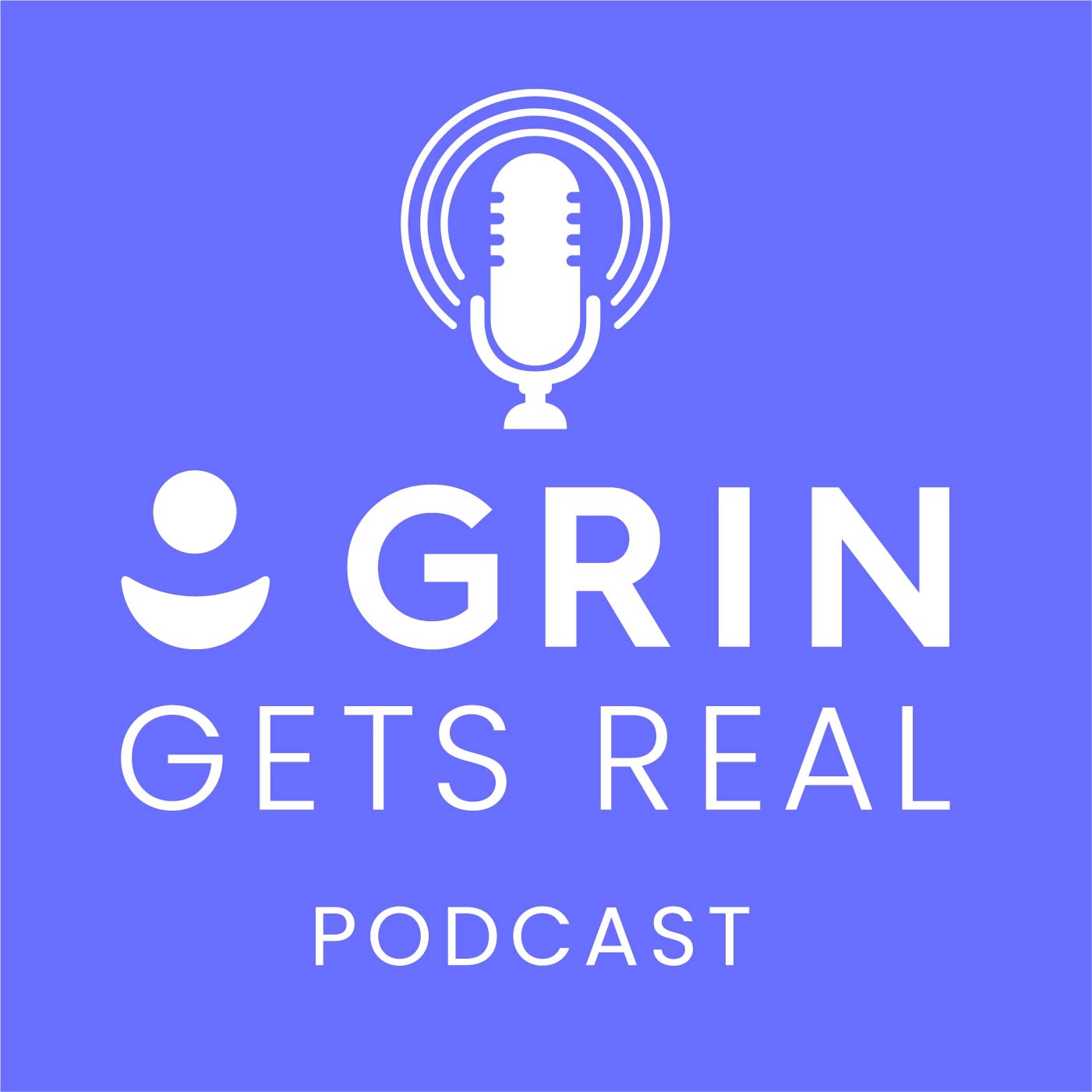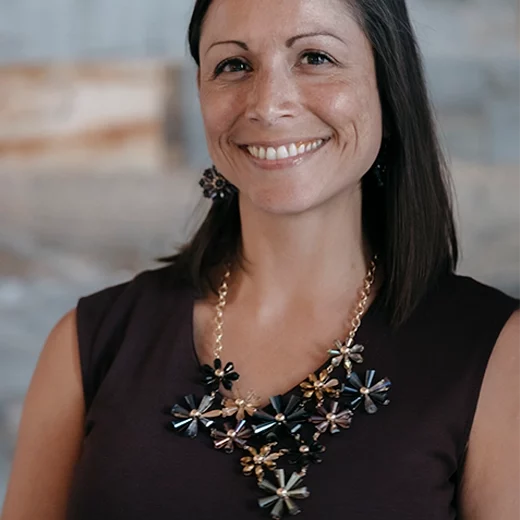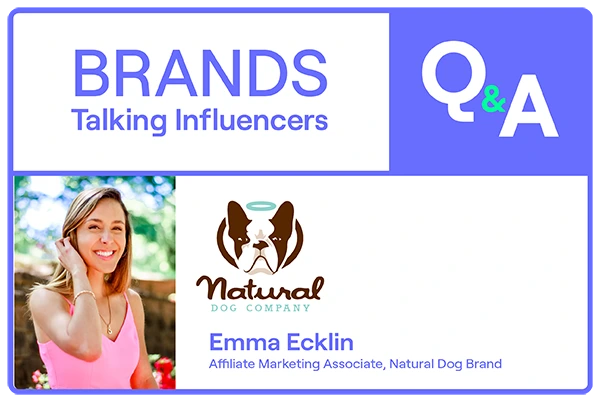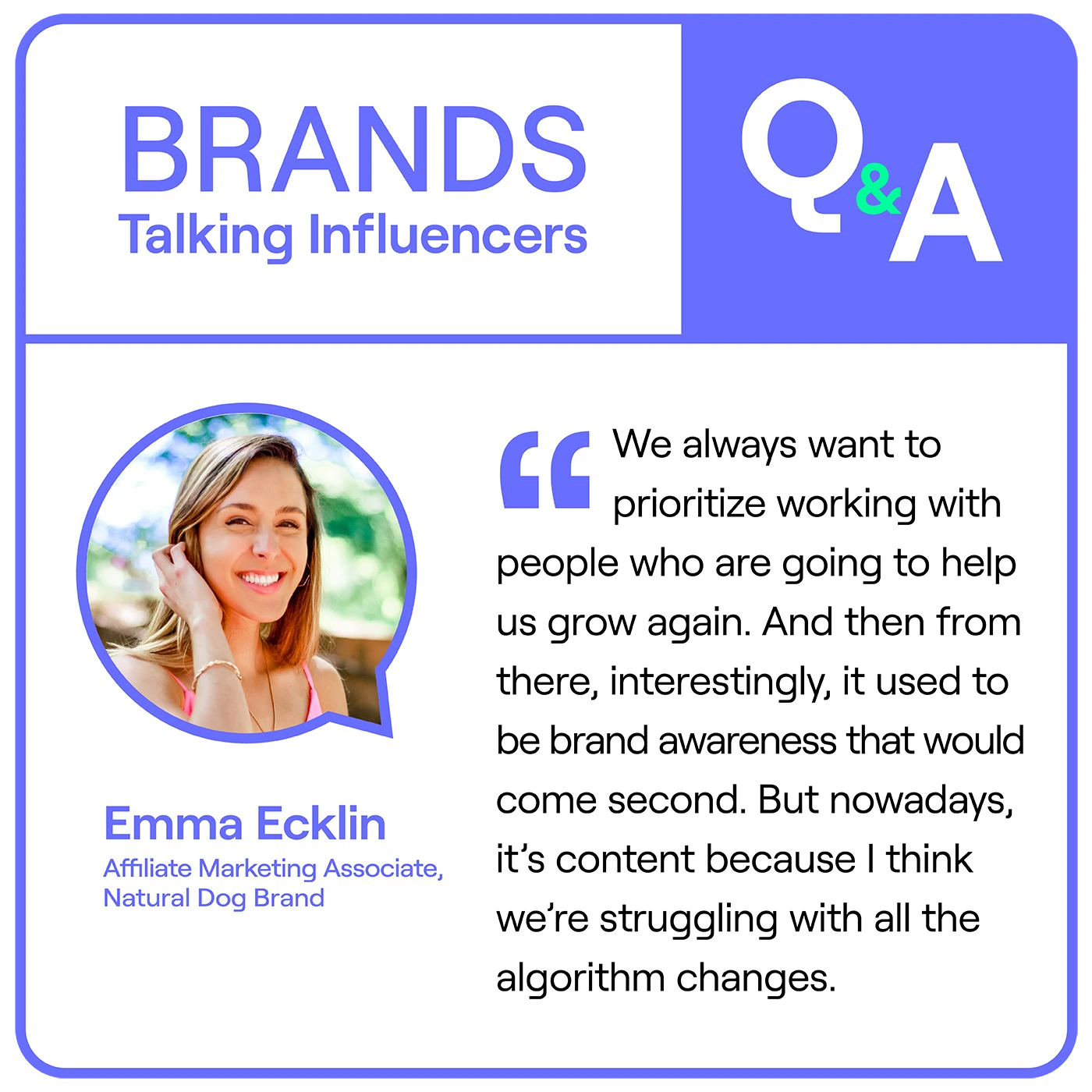

Director of Marketing
Content at GRIN
Welcome to the GRIN gets real podcast, the show for people who want to maximize their marketing potential. From influencer marketing to eCommerce strategy and everything in between, each episode will feature industry experts that share their insights and provide actionable tips to help you achieve your marketing goals. Subscribe and stay tuned!

[audio src="https://grin.co/wp-content/uploads/2022/08/20220809_QA-Natural-Dog-1.mp3" /]
Affiliate Marketing Manager
Natural Dog Company provides natural, effective, and holistic healing solutions for canine companions. From healing balms and natural supplements to shampoos and bully bars, the company’s team of dog lovers provides high-quality solutions for dogs of every age, size, breed, and gender.
Natural Dog Company provides natural, effective, and holistic healing solutions for canine companions. From healing balms and natural supplements to shampoos and bully bars, the company’s team of dog lovers provides high-quality solutions for dogs of every age, size, breed, and gender.
In this Brands Talking Influencers webinar, Katya sits down with Emma Ecklin, an affiliate marketing associate at Natural Dog Company. Together, they dive into what Natural Dog Company has learned from its testing results and how that has shaped its growing influencer program. Emma also stuck around to answer additional viewer questions, which you hear exclusively on the GRIN Gets Real podcast.
“It’s interesting to see that Stories tend to convert better for us than posts because I think from a consumer standpoint, it’s simpler steps. Just swipe up on a Story and go in and buy a product. So I’m always looking at how much Story content our creators are posting about us.”
It’s nearly impossible to predict what type of content works best for your campaign without testing it first. In this episode, Emma and Katya discuss some of the surprising test results Natural Dog Company has found during its campaigns, how Emma arrived at them, and how she responded.
This episode of the podcast also covers:

“Revenue is at the top [of the priority list] for us. And that is really focused on the commission-based model. We do drive a significant amount of revenue from our creators who are commission-based. And as a brand, we always want to prioritize people who are going to help us grow.”
“I like to give creators as much autonomy as they want, so their content fits with their audience, but I think they are looking for more ideas from you than you may think. So we tested out giving them more creative guides of exactly what we are looking for. Ultimately, you get to create the content—you’re the expert—but this is what we have in mind.”
“Brands need to realize it’s as much of a privilege for the brand to work with the creator as it is for the creator to work with the brand. I don’t think brands should always think that they should cater to everyone who wants to work with them. It’s OK to be more specific and more picky.”
“At the end of the day, we want to see [our creators] succeed. We want them to reach their goals just as much as ours. So it’s important to share knowledge.”
Katya Allison (intro):
Welcome to Brands Talking Influencers Q&A, where we take our fireside chat to the GRIN Gets Real podcast.
During the latest brands talking influencers fireside chat, How to Scale Your Influencer Program Via Testing, we shared influencer marketing insights from Natural Dog Company. During the live portion, we discussed how they leverage their creator community for content to repurpose across multiple marketing channels, building brand awareness, and acquiring new customers. We also touched on workflow best practices, how to test with purpose, and then finding creators at any stage of an influencer program. While we had a live Q&A, there were just too many questions to go over. So we’re bringing those unanswered questions to the GRIN Gets Real podcast.
So, put your AirPods in, turn up that volume and get ready for those unanswered questions with Emma from Natural Dog Company.
Katya Allison:
Emma, welcome back to the other side of Brands Talking Influencers. This is the GRIN Gets Real podcast, where we take all of those unanswered questions and get all the good tidbits from those answers. Are you ready?
Emma Ecklin:
I am ready.
Katya Allison:
How many creators do you actively work with?
Emma Ecklin:
I would say around 100, actively. And that is on a weekly basis. I interact with them each week. We do have a pocket of people who I hear from once a month or bi-weekly, but there is a small group that I am in constant communication with. And that’s not always via email necessarily. I’m just sometimes in their DMs being like, “So cute!”
Katya Allison:
What is your program’s objective? This is a really great question. I think we answered it during the chat, but maybe we can revisit.
Emma Ecklin:
Revenue is at the top for us. And that is really focused on the commission-based model. We do drive a significant amount of revenue from our creators who are commission-based. And as a brand, we always want to prioritize people who are going to help us grow. Again, making sure it’s both sides.
From there, it used to be brand awareness. But nowadays, it’s content. Right now, we are struggling with all the algorithm changes. We thought we had our content figured out, but with videos and stuff, we need more of it, and we are not necessarily getting the content we are looking for, knowing it’s going to perform well with us. So some of our creators are more humor-based and cutesy, which is great.
But because we are a very educational brand, our content needs to focus on the messaging. So, right now, I am really focusing on being even more specific. But also, where is that fine line of giving them the autonomy of content? Because for campaigns, they are always getting a product from us too and focusing on an individual product and trying to create stronger content. Most are very open to letting us use the content on our end. But it’s important that the content they produce is something we can use.
For brand awareness, I focus more on engagement because that tends to reach people deeper than just the total reach of how many people they reach when they post the content. So, I like to see the engagement number go up when we run campaigns.
Katya Allison:
I’m right there with you when it comes to engagement. Especially from a content repurposing standpoint as well. It’s a great number for seeing what resonates with an audience.
OK, so please share a little bit about your workflow when working with creators. Are you setting up multiple campaigns? Is it just one campaign?
Emma Ecklin:
I mentioned earlier what I like to call our evergreen program. And this is just a very basic requirement to work with Natural Dog Company. So if they’ve tried our products through product gifting and they come into this evergreen program and are very passionate about us as a brand and want to work on campaigns we’re running, that’s the overarching piece of it. Then I break it down. And usually, month by month, I’ll have at least one other. It also needs to align with our promotions and new product launches. And this is something that needs to be prioritized because, with new products, we don’t even have UGC to use. So that’s really a priority. And it’s also more exciting because they are the first to get to try a new product.
We did a summer skin sale last summer, and before we did that promotion, I was working with creators and letting them pick out of our summer collection from products that really help during the summer heat. So based on that, I ask myself if there are certain creators we have that I know whose dogs struggle with an issue. That way, they can be more authentic when they create that content because their audience knows that the dog has issues, and this is how they are solving them. So I just kind of funnel them in and pick who I think best resonates with a certain campaign. So then I’ll pause them in the evergreen and funnel them into an activation. Then from there, it works just like any other campaign. We use an interesting model, I think, but we have seen a lot of success with it.
Katya Allison:
I love that you have that top-of-funnel approach with your creator campaign.
Emma Ecklin:
For sure. And I like to give creators as much autonomy as they want, so their content fits with their audience, but I think they are looking for more ideas from you than you may think. So we tested out giving them more creative guides of exactly what we are looking for. Ultimately you get to create the content—you’re the expert—but this is what we have in mind. And I think creators, especially those more focused on monetizing their accounts, need content ideas. And I think you need to make sure you have that relationship but don’t necessarily think you can’t speak up or give guidance on what you’re looking for.
Katya Allison:
What is the biggest lesson you’ve learned when working with creators, and how has it helped you adapt your program?
Emma Ecklin:
OK, I’ll be a little more specific with this example, but I’m bringing it back to testing out different niches and testing which influencer type works best with our brand.
There was a bigger account that reached out to us to do a collaboration. And this was definitely a bigger negotiation price than we had done before, but we were open and willing to try it. We thought they were a good fit, and we did our research on whether the creator works with our brand well and how often they post with their dog, etc. But despite having the audience we were looking for in it (and this was an audience in the millions), but it was full of people who might be animal lovers but didn’t have one themselves. So they are not going to be purchasing a dog product because they don’t need it. They are just following this account because it’s funny and cute.
So that was an interesting test. We went in with a big revenue goal. The impressions and engagement skyrocketed, but there wasn’t anything to show for it on the revenue side of things. That was probably the biggest lesson I learned.
Katya Allison:
That’s a good lesson. It’s the fail forward. That’s essentially what it is you’re saying.
OK, so have you ever had to let an influencer go? How did you handle it?
Emma Ecklin:
I have done it before. When I took over the evergreen program, there were a lot of people we had on our roster who weren’t active and didn’t have the following we were looking for. Some of them hadn’t posted in like two years. And I would find them in GRIN and ask them if they’re still around and posting. Essentially, we’ll archive a creator if they don’t want to work with us anymore.
And brands realize it’s as much of a privilege for the brand to work with the creator as the creator to work with the brand. I don’t think brands should always think that they should cater to everyone who wants to work with them. It’s OK to be more specific and more picky.
So, when I end it with a creator, it’s usually a good breakup. I think if they aren’t passionate about your brand, it’s just not going to work. It’s OK to have to let a creator go if they have different priorities. You have to just be honest with them. Some people go a little crazy on social media, and maybe they don’t fit with your brand message anymore. And that’s OK. But you have to be upfront about it and as civil and mature as you can.
Katya Allison:
What types of information do you share with the influencers to create content? I know you want them to do what’s best for their audience, but you still need to provide some sort of guidance.
Emma Ecklin:
We’ve become more specific lately. Essentially I will attach a brand asset to the campaign that I’m offering to the influencer. And it can be something basic that you make in a Google Doc. But I always work with our social media manager. I ask them what they’re seeing on their end in terms of what content is performing well. Then I can put that into a campaign doc that I’m giving to the creator to give them an idea of what will work best. We’re basically just giving them a bunch of bullets of tips that we’ve learned. We’re doing research on our end of what works and what doesn’t, so we share that with them.
Then we just tell them that if they want us to repost them on our main account, there are certain guidelines that we need. So, we’ve gotten more specific, and we try to be very open to their messaging. But at the same time, we want the creator to be speaking because the creator has trust with their audience. So, in the guideline, we just give them some bullets on why they can trust Natural Dog Company. But we keep it very vague in hopes that they understand that they can fit their specific tone and message in there.
At the end of the day, we want to see them succeed. We want them to reach their goals just as much as ours. So it’s important to share knowledge. And in this day and age, you can Google about anything. So it’s just about finding your specific way of sharing knowledge.
Katya Allison:
What KPIs do you use to measure performance?
Emma Ecklin:
From the GRIN reporting (that’s where I do all our metrics), I am focusing on conversions. At this point, it’s really about how many discount codes are used because we don’t really get a lot of traffic with our links. So we focus on how many conversions, how much revenue was generated, as well as impressions and engagements, and I’ve started paying attention more to shares because I find that something has resonated more with that content when it’s shared. So, I’ve been dialing more into those metrics as well to see what content is performing well. What works well one week might not work the next week, so it’s really important to see that shift week by week in my reporting to make sure I’m on top of it.
Oh, and also, how many content pieces? I always like to see that number go up because the more you post, the more likely it is that someone is going to see you. So I like to see our creators posting more about us. And that could just be a Story or a feed post that lives longer. It’s interesting to see that Stories tend to convert better for us than posts because I think from a consumer standpoint, it’s simpler steps. Just swipe up on a Story and go in and buy a product. So I’m always looking at how much Story content our creators are posting about us.
Katya Allison:
This one is about gifting. If the number of influencers who post after receiving the product is so low, is it worth it?
Second part: Can you get a positive ROI with the gifting campaign model?
Emma Ecklin:
I think you have to break it down from your product cost and what you can send out in volume. So for us, we’re smaller ticket items, so we can send those products out more from the business side and the cost side. But again, if you have a higher ticket item, you’re not able to gift these all the time, so no, it’s probably not worth it to have a whole gifting campaign and workflow. We have found success with it with the expectation of content. The percentage may not be high, but I have been able to funnel them into joining our creator program, and it’s another way of saving me time from the outbound side of reaching out to creators because I’m not necessarily having to reach out frequently to get them to join the program. So I think if you are just sending out a product with no goal in mind, of course, it’s not worth it. But if you are looking for new eyeballs on your products, then yes. If your budget allows you to send out products, then yes, it is worth it. It’s tricky, but you have to start with your brand and products and what you are allowed to send out. And if it’s a very small volume, then maybe shift it into a different model.
Katya Allison:
How do you decide what content to post to your Instagram grid? Do you repost creator content?
Emma Ecklin:
We do. We’re not able to reshare if they have a code. That’s more for Stories, though, because most people aren’t putting their code in their feed. So if we are repurposing our creators, they are always tagged and credited. We also work with a bunch of general accounts of dog breeds, and that’s a big help for the creators because these accounts have huge followings. But it’s really important that we get that sign-off to use that content, and if creators don’t want us to use it, that’s OK. We want to make sure we respect your space because these days, people are taking other people’s content without asking, and it’s not OK. So we are very careful about how we repurpose that content. So for social media, we will repurpose it on our Instagram, whether it’s a Story or a hard post. We also like to do the collab button on Instagram, so it’s combining with the creator themselves. We’ve found that when you do the collab feature with the creator versus them giving us the right to take the content, the engagement tends to spike because the creator already has a better relationship with their audience, and they are responding and commenting. So it shows up on our feed, but it helps improve that engagement, and the creator gets recognized that they are working with Natural Dog Company, and we get to see new audience members when we use that collab feature.
Katya Allison:
I love that little nugget of wisdom! The collab button, I think, is a great tidbit to leave for people who want to repurpose content and want to see that engagement.
Well, Emma, I cannot thank you enough for spending so much time with me. I hope you will join me again for another one sometime!
Emma Ecklin:
For sure!
Katya Allison:
I hope you enjoyed that just as much as I did. Emma’s approach to adjusting your program based on the performance of her campaigns is vital for a successful influencer program. It also really proves that it’s not as easy as it looks. It truly does take digging in and finding what’s working and what’s not and improving with that information.
Now, if you’re interested in watching the fireside chat with Emma, or other brands that we’ve featured in the past, like Vera, Bradley Trifecta, Gainful and more, visit the Live Events section at grin.co.
Before I let you go, I have a special announcement. On August 25, GRIN is putting together its first all-day virtual event, AUTHENTIC: Marketing in the Creator Economy.
Authentic influencer marketing enables brands to own their direct relationships with creators to deliver more trust to the consumer through influencer content. This one-day event will focus on helping brands drive authentic relationships with consumers at scale, showcase how to cultivate honest endorsements with influencers, and explore a full-funnel approach to influencers that supports the entire marketing strategy.
Want to hear more? Be sure to subscribe to the GRIN Gets Real podcast to get the latest episodes. And be sure to give us a rating and leave a review. Let us know what you love. And on that note, keep grinning!


Director of Marketing
Content at GRIN
Welcome to the GRIN gets real podcast, the show for people who want to maximize their marketing potential. From influencer marketing to eCommerce strategy and everything in between, each episode will feature industry experts that share their insights and provide actionable tips to help you achieve your marketing goals. Subscribe and stay tuned!